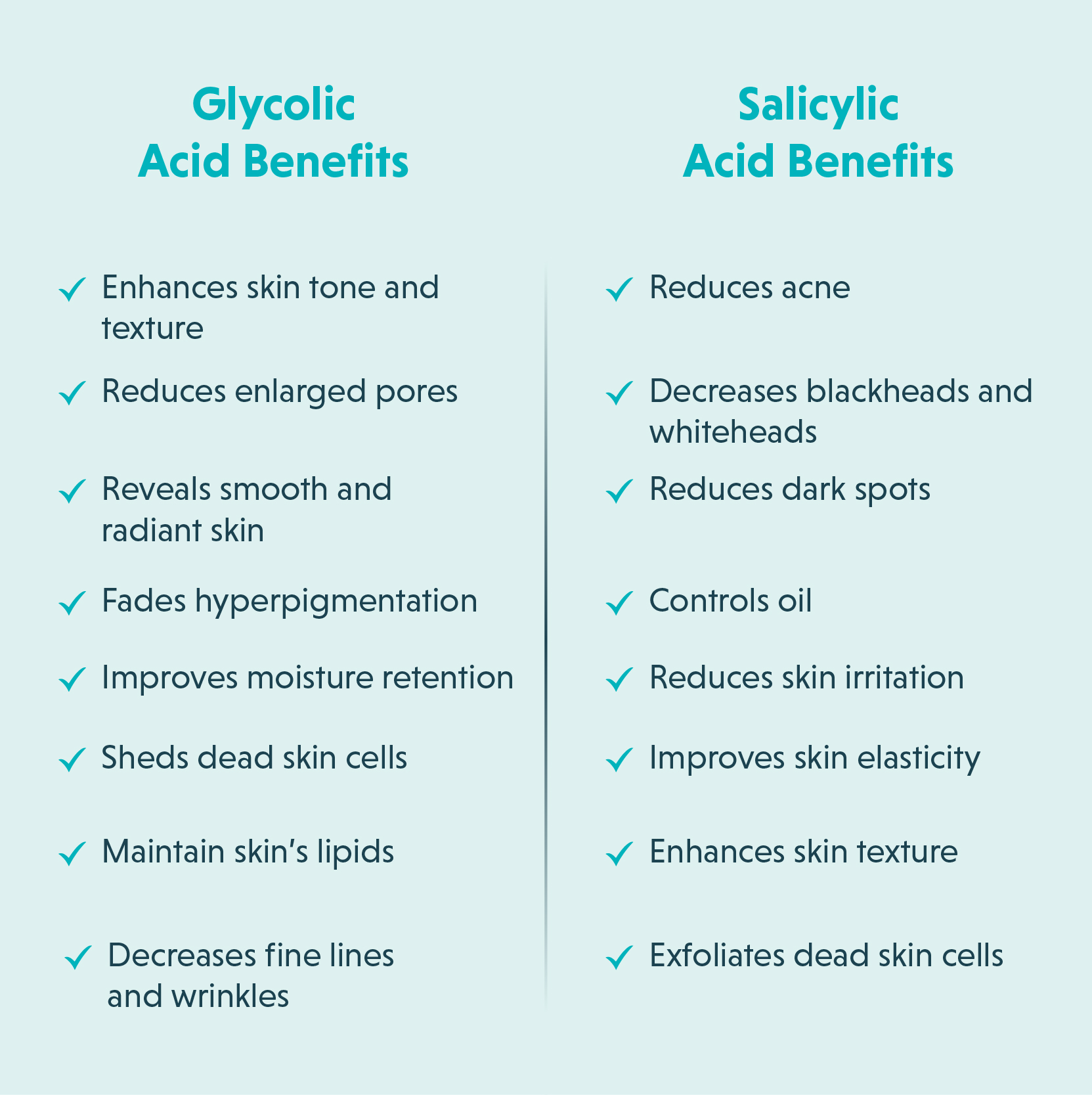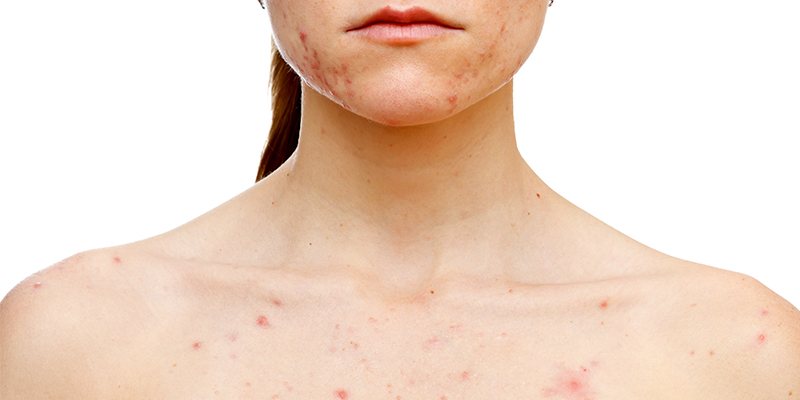Glycolic Acid vs Salicylic Acid: Which Is Better For Your Skin
Glycolic acid and salicylic acid are two effective skincare ingredients renowned for their transformative effects and distinct benefits. Glycolic acid, a water-soluble AHA, comes from sugarcane. On the other hand, salicylic acid is an oil-soluble beta-hydroxy acid (BHA) derived from willow bark. AHAs and BHAs have exceptional exfoliating properties and offer unique solutions for different skin concerns and types. We’ll delve into understanding What is glycolic acid, the Benefits & side effects, how to use it, and the comparison with salicylic acid. Let’s also explore – can we use salicylic acid and glycolic acid together, or how can you integrate them into your skincare routine?
In This Article

Glycolic Acid vs Salicylic Acid: Which Is Better For Your Skin?
Both glycolic acid and salicylic acid are effective ingredients one can incorporate into their daily skincare routine. Often used to treat hyperpigmentation and ageing concerns, glycolic acid benefits for skin are more visible in people with sensitive and dry skin types. On the other hand, those with oily and acne-prone skin, can opt for salicylic acid to help with skin redness and irritation.
Pros and Cons
Glycolic acid and salicylic acid address a range of skin issues. Here are some pros and cons of using these skincare ingredients.
Glycolic Acid:
Pros
- Reduces fine lines and wrinkles
- Excellent for improving skin tone and texture
- Treats hyperpigmentation and skin damage from the sun
Cons
- May cause redness and irritation, especially in sensitive skin
- Causes an increase in sensitivity towards the sun
Salicylic Acid:
Pros
- Excellent for treating acne
- Highly effective in reducing inflammation and redness
- Removes debris and excess oil
Cons
- Causes peeling and dryness
- Not recommended for dry and sensitive skin
Understanding Exfoliating Acids
Think of AHAs and BHAs as two of the main classes of hydroxy acids used in skincare. They work as chemical exfoliants in skincare products such as facial serums, cleansers, toners, body lotions, and more. The challenge may be discovering the right product for your skin concern and type. To choose the most suited product, you may also speak to an expert who can recommend the safest product by diagnosing your skin condition. [1]
What is Salicylic Acid?
Salicylic acid, derived from willow bark, is a natural exfoliator. The salicylic acid benefits on skin involve exfoliating dead skin cells, treating acne, and reducing inflammation. Understanding what is salicylic acid and the uses of salicylic acid on face can help in the effective management of oily and acne-prone skin. However, salicylic acid side effects may include irritation, peeling, and dryness.
Salicylic Acid Benefits:
- Reduces acne
- Decreases blackheads and whiteheads
- Reduces dark spots
- Controls oil
- Reduces inflammation
- Reduces skin irritation
- Improves skin elasticity
- Enhances skin texture
- Exfoliates dead skin cells [2]
Salicylic Acid Side Effects:
- Dryness
- Peeling
- Scaling
- Irritation
- Itchiness
- Shedding
- Stinging
- Redness
- Sensitivity to sunlight [3]
What Is Glycolic Acid?
Glycolic acid, derived from sugar cane, is oil-soluble. Glycolic acid benefits for skin include reducing fine lines, improving texture and tone, and treating hyperpigmentation. However, a few glycolic acid side effects include redness, irritation and increased sensitivity to sunlight. Knowing what is glycolic acid and how to use glycolic acid correctly is crucial if you want to maximise results and minimise side effects. [4]
Glycolic Acid Benefits:
- Enhances skin tone and texture
- Reduces enlarged pores
- Reveals smooth and radiant skin
- Fades hyperpigmentation [5]
- Improves moisture retention
- Sheds dead skin cells
- Maintains skin’s lipids
- Decreases fine lines and wrinkles [6]
Glycolic Acid Side Effects:
- Redness
- Irritation
- Dryness
- Peeling
- Increased sun sensitivity
- Burning sensation
- Itchiness
- Skin rash
Salicylic vs Glycolic Acid
Feature |
Glycolic Acid |
Salicylic Acid |
| Chemical Classification | Alpha Hydroxy Acid (AHA) | Beta Hydroxy Acid (BHA) |
| Molecular Size | Smaller | Larger [7] |
| Source | Derived from sugar cane | Derived from willow bark |
| Solubility | Water-soluble | Oil-soluble |
| Exfoliation Method
|
Dissolves bonds between dead skin cells | Penetrates and cleans out pores |
| Primary Benefits
|
Skin brightening, Anti-ageing | Anti-inflammatory, acne treatment |
| Skin Types
|
Suitable for dry, sensitive, and ageing skin | Suitable for acne-prone and oily skin [8] |
| Usage | Nightly or every other night | Daily or as required |
| Concentration | 5-10% in OTC products, up to 70% in peels | 0.5-2% in OTC products, higher in peels |
| pH Level | Typically around 3.5 | Typically around 3.0 |
| Sensitivity | Higher potential for irritation | Moderate potential for irritation |
| Sun Sensitivity | Increases sensitivity | Mild increase in sensitivity |
| Common Uses | Fine lines, wrinkles, hyperpigmentation | Acne [9], oily skin, blackheads |
| Precautions | Start with lower concentrations, use sunblock | Avoid overuse, use sunblock |
| Penetration Depth | Deep penetration | Surface/pore-level penetration |
| Moisture Retention | Improves hydration | May cause dryness |
| Anti-Aging Properties | Strong | Moderate |
| Anti-Inflammatory | Mild | Strong |
| Comedolytic Properties | Moderate | Strong |
| Effect on Sebum Production | Minimal | Reduces sebum production |
| Application Frequency | 2-3 times a week | Daily or as needed |
| Compatibility with Other Ingredients | Varies, avoid with retinol | Varies, avoid with other BHAs/AHAs
|
| Texture Improvement | Significant | Moderate |
| Post-Inflammatory Hyperpigmentation | Reduces | Reduces |
| Acne Treatment | Mild to moderate | Strong |
| Collagen Stimulation | Yes | Minimal |
| Skin Brightening | Yes | Yes |
| Formulation Types | Creams, serums, peels | Cleansers, toners, creams |
| Shelf Life | Varies by formulation | Varies by formulation |
| Typical Concentrations in Professional Treatments | Up to 70% | Up to 30% |
| pH Adjustments | Necessary for stability | Necessary for stability |
| Odour | Minimal | Minimal |
| Cost | Generally moderate | Generally moderate |
Adding Salicylic and Glycolic Acids to Your Daily Skincare Practice:
When incorporating glycolic acid and salicylic acid together into your skincare regimen, it’s essential to know your skin type and consider the concentration of the products. As a safety precaution, start with lower concentrations. This can help you gauge how your skin reacts, and then you can gradually increase based on your skin’s tolerance. It is always wise to conduct a patch test first to confirm adverse reactions, if any.
Glycolic Acid:
- Glycolic acid benefits for skin include improving tone and texture.
- Use in the nighttime, 2-3 times a week.
- Apply after cleansing and before moisturising.
- As glycolic acid side effects can include increased sun sensitivity, use sunscreen at all times during the day.
Salicylic Acid:
- Salicylic acid benefits on skin include reducing inflammation and treating acne.
- Use daily or as needed.
- Apply after cleansing.
- Use salicylic acid as toners, cleansers, or spot treatments.
Potential Interactions and Sun Protection:
- Avoid using glycolic acid and salicylic acid together initially, as they may potentially irritate.
- Introduce both acids gradually into your routine. Start applying one in the morning and the other at night.
- Follow up with a hydrating moisturiser or serum.
- Avoid using other exfoliants simultaneously to prevent over-exfoliation and irritation.
- Always use sunblock to protect your skin from UV damage.
Takeaway
Glycolic acid and salicylic acid are both excellent and effective chemical exfoliants. They both repair sun damage, among other specific concerns. Great for anti-ageing and skin brightening, glycolic acid benefits for skin involve encouraging new cell growth. Highly effective for acne-prone and oily skin, salicylic acid benefits on skin include reducing excess sebum and unclogging pores. You can make a choice based on your skin type and concerns. When paired correctly and used in appropriate concentrations, these two acids can provide a powerful combination for improving acne, texture, and tone.
Frequently Asked Questions On Glycolic Acid And Salicylic Acid
Yes, but start slow and small. You may gradually increase concentration and application based on the skin’s reaction.
Salicylic acid works better for acne due to its anti-inflammatory properties.
Avoid using it with retinol or other strong acids, and make sure you apply sunscreen.
Salicylic acid is best for treating acne, while glycolic acid works better for anti-ageing.
Initially, it may cause purging, but acne should not worsen over time.
Yes, you can use salicylic acid every day, especially if yours is acne-prone and oily skin. However, check for dryness and irritation.
Start gradually and with a lower concentration, using it once daily. Increase as tolerated.
If you experience severe irritation or dryness. Stop if your dermatologist recommends it.
People with sensitive or dry skin should avoid using salicylic acid.
Avoid mixing salicylic acid with retinoids or other strong acids.
Glycolic acid exfoliates the skin, brightens the complexion, and improves texture.
Glycolic acid can help lighten your complexion by exfoliating the top layer of skin.
Glycolic acid is helpful for anti-ageing, while salicylic acid is better for acne.
People with highly sensitive or irritated skin should avoid using glycolic acid.
Dry, sun-damaged, and ageing skin types should benefit most from using glycolic acid.
Glycolic acid exfoliates, treats acne and breakouts, and reduces oiliness.
Yes, salicylic acid is highly beneficial to treat pimples and prevent breakouts.
Read This Next

Skin Picking Disorder (Excoriation): Causes, Symptoms, Treatment & Prevention Tips

Know The Top 11 Benefits Of Drinking Green Tea For Skin

MNRF Treatment In Chennai: Cost, Results & Procedure

Glutathione Tablets For Skin Whitening: How To Use, Benefits & Side Effects

Lactic Acid Peel – Benefits, Side Effects, Before & After Results



